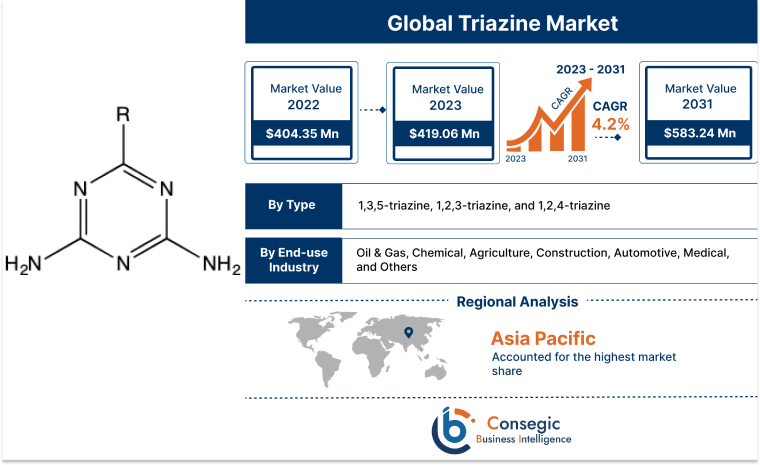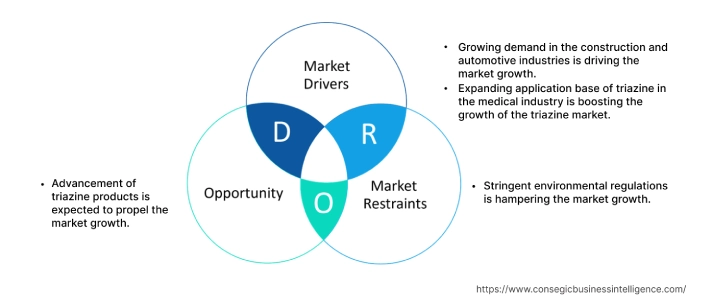Triazine Market Size :
Consegic Business Intelligence analyzes that the triazine market size is growing with a CAGR of 4.2% during the forecast period (2025-2032), and the market is projected to be valued at USD 591.25 million by 2032 and USD 436.91 million in 2025 from USD 426.76 million in 2024.
Triazine Market Scope & Overview:
Triazines are aromatic compounds, which have a planar ring structure with delocalized electrons. This gives them several desirable properties, such as stability, color, and reactivity. They have a wide range of applications in agriculture, chemical, medical, and other industries. They are generally considered to be safe for use, but some concerns have been raised about their potential environmental impact. Also, some herbicides have been shown to persist in the environment for long periods and can accumulate in the food chain.
Overall, they are a versatile class of compounds with a wide range of applications. They are an important part of the chemical sector and have a significant impact on different industrial usage.
Triazine Market Insights :
Triazine Market Dynamics - (DRO) :
Key Drivers :
Growing demand in the construction and automotive industries is driving market growth.
Triazine-based resins and adhesives are in high demand in the construction and automotive industries due to their excellent performance properties. These resins and adhesives are known for their strength, durability, and adhesion. They are very strong and can withstand high loads. These resins and adhesives are durable and can withstand harsh environmental conditions, such as extreme temperatures, chemicals, and moisture. They also have excellent adhesion to a variety of materials, including metals, plastics, and composites. These adhesives are used to bond a variety of building materials, such as concrete, metal, and wood. They are also used in a variety of applications, such as bonding reinforcing bars in concrete, bonding metal panels to buildings, and bonding wood panels in furniture. Moreover, these resins are used in coatings for vehicles and aircraft as well. These coatings are known for their durability, resistance to chemicals and moisture, and ability to protect the underlying substrate from corrosion. Furthermore, an analysis of market trends shows that the growing construction sector is boosting market growth. For instance, according to a report by Invest India in 2023, construction development sector inflows in India were around USD 26.38 billion between April 2000 and June 2023. The report also states that the construction industry in India is expected to reach USD 1.4 trillion by 2025. Hence, increasing demand in the construction and automotive sectors is propelling the triazine market growth.
The expanding application base in the medical sector is boosting the triazine market
Triazine derivatives, such as dacarbazine and temozolomide, are used in the treatment of cancer. These drugs work by damaging the DNA of cancer cells, which prevents them from dividing and growing. These derivatives, such as amodiaquine and pyrimethamine, are used in the treatment of malaria. These drugs work by killing the malaria parasite in the blood. They are also used in the production of other medical products, such as anticonvulsants, antihistamines, and antidepressants. These derivatives are being developed as new drugs to treat Alzheimer's disease, Parkinson's disease, and other neurological disorders. As per the analysis of market trends, the expanding application base in the medical sector is boosting the triazine market growth.
Key Restraints :
Stringent environmental regulations are hampering the market.
Triazines are subject to several environmental regulations, which can increase the cost of production and make it more difficult to expand into new markets. For instance, some herbicides have been shown to persist in the environment for long periods and can accumulate in the food chain. This has led to concerns about the environmental impact of herbicides, and some countries have banned or restricted their use. Hence, the market analysis shows that the aforementioned factors hamper the triazine market demand.
Future Opportunities :
The advancement of products is expected to propel the market.
Triazine producers are developing new products with improved performance properties and lower environmental impact. New products are being developed with improved performance properties such as high strength, durability, adhesion, UV resistance, thermal conductivity, electrical conductivity, and others. These improved performance properties are making products more attractive for a wider range of applications. For instance, new resins with improved strength and durability are being widely demanded in automotive and aerospace applications. New adhesives with improved adhesion and resistance to chemicals and moisture are also being used in construction and manufacturing applications. Furthermore, these products are also being developed with lower environmental impact. The resins and adhesives are made from bio-based materials, and they have low VOC emissions. As per the analysis of market trends, by developing new products with improved performance properties and lower environmental impact, producers are expanding the triazine market opportunities.
Triazine Market Report Insights :
| Report Attributes | Report Details |
| Study Timeline | 2019-2032 |
| Market Size in 2032 | USD 591.25 Million |
| CAGR (2025-2032) | 4.2% |
| By Type | 1,3,5-triazine, 1,2,3-triazine, and 1,2,4-triazine |
| By End-use Industry | Oil & Gas, Chemical, Agriculture, Construction, Automotive, Medical, and Others |
| By Region | North America, Europe, Asia-Pacific, Latin America, and Middle East & Africa |
| Key Players | Hexion, Eastman, Stepan, Lonza, Evonik, DBWT, Baker Hughes, Dow Chemical, Ecolab, Sintez OKA, and Foremark Performance Chemicals |
| Geographies Covered | |
| North America | U.S. Canada Mexico |
| Europe | U.K. Germany France Spain Italy Russia Benelux Rest of Europe |
| APAC | China South Korea Japan India Australia ASEAN Rest of Asia-Pacific |
| Middle East and Africa | GCC Turkey South Africa Rest of MEA |
| LATAM | Brazil Argentina Chile Rest of LATAM |
| Report Coverage | Revenue Forecast, Competitive Landscape, Growth Factors, Restraint or Challenges, Opportunities, Environment & Regulatory Landscape, PESTLE Analysis, PORTER Analysis, Key Technology Landscape, Value Chain Analysis, Cost Analysis, and Regional Trends & Forecast |
Triazine Market Segmental Analysis :
By Type :
The type segment is categorized into up to 1,3,5-triazine, 1,2,3-triazine, and 1,2,4-triazine. In 2024, the 1,3,5-triazine segment accounted for the highest market share of 41.55% of the overall triazine market share and is expected to grow at the fastest CAGR over the forecast period in the global triazine market. It is the most common isomer and is used in a wide range of applications such as herbicides, pharmaceuticals, dyes and pigments, explosives, and others. It is more popular than other isomers owing to its unique chemical properties, which make it ideal for a variety of applications. For instance, it is very stable and resistant to hydrolysis, which makes it ideal for use in herbicides. It is also very versatile and can be easily modified to create new compounds with different properties. Furthermore, the increasing usage of triazine-based herbicides in the agricultural sector, the growing requirement for triazine-based resins and adhesives in the construction and automotive industries, and others are driving the segment. Hence, the market analysis depicts that due to its unique chemical properties and wide range of applications, the segment is witnessing a significant rise in the triazine market trends.
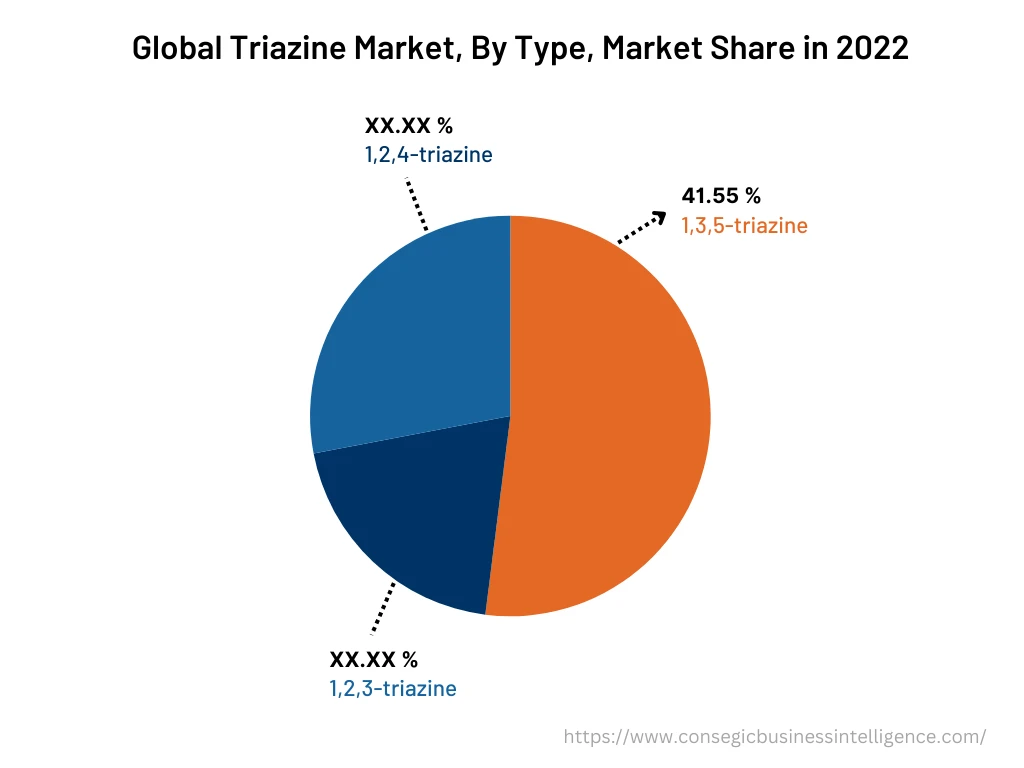
By End-Use Industry :
The end-use industry segment is categorized into oil & gas, chemical, agriculture, construction, automotive, medical, and others. In 2024, the agriculture segment accounted for the highest market share of the triazine market share. Triazine herbicides are widely used to control a wide range of weeds in a variety of crops, including corn, soybeans, wheat, and cotton. They are effective against both annual and perennial weeds. They are also used to provide nitrogen to plants. Triazine pesticides are used to control a variety of pests as well, such as insects, diseases, and fungi. Also, analysis of segment trends shows that the increasing agricultural sector is driving the segment. For instance, according to a report by the Press Information Bureau in 2023, India's agriculture sector has been witnessing robust growth with an average annual growth rate of 4.6 percent over the last six years. Hence, due to the aforementioned factors, the segment is witnessing significant growth in the triazine market demand.
Moreover, the medical segment is expected to grow at the fastest CAGR over the forecast period in the market. The derivatives are used in the production of a variety of pharmaceuticals, such as antineoplastic agents, antimalarial drugs, and anticonvulsants. In addition to these specific applications, these derivatives are also being investigated for their potential use in the treatment of a variety of other diseases, such as Alzheimer's disease, Parkinson's disease, and HIV/AIDS. Furthermore, analysis of segment trends shows that the increasing prevalence of chronic diseases, growing requirement for personalized medicine, development of new triazine-based drugs, and others are driving the triazine market trends.
By Region :
The regional segment includes North America, Europe, Asia Pacific, the Middle East and Africa, and Latin America.
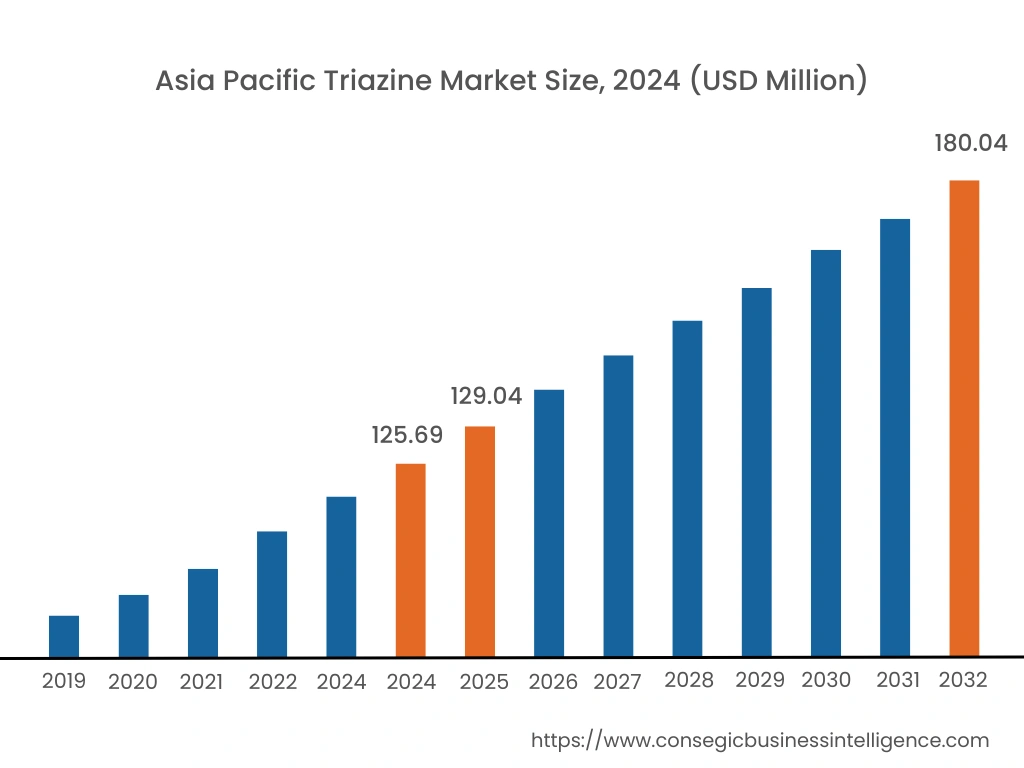
In 2024, Asia Pacific accounted for the highest market share at 36.75%, valued at USD 125.69 million in 2024 and USD 129.04 million in 2025, it is expected to reach USD 180.04 million in 2032. The triazine market analysis shows that in the Asia Pacific region, China accounted for the highest market share of 22.10% during the base year 2024. China is the largest consumer and producer in the world. The increasing need for herbicides in the agricultural sector and the expanding application in the medical and biological energy industries in the region are driving the market in the Asia Pacific. Furthermore, analysis of regional trends portrays that the increasing construction activities across the region are playing an influential role. For instance, according to a report by Make in India in 2023, more than 40% of the population is expected to live in urban India, creating a demand for 25 million additional mid-end and affordable units by 2030. Hence, due to the increasing construction sector, the segment is experiencing positive growth in the triazine market expansion.
As per the triazine market analysis, North America is expected to witness a significant rise over the forecast period, growing at a CAGR of 3.90% during 2025-2032 owing to increasing investment in the oil and gas sector in the U.S. Also, rising disposable incomes and increasing awareness about healthcare are driving the triazine-based pharmaceuticals in the region. Hence, owing to the aforementioned factors, the region is witnessing positive progress in the triazine market opportunities.
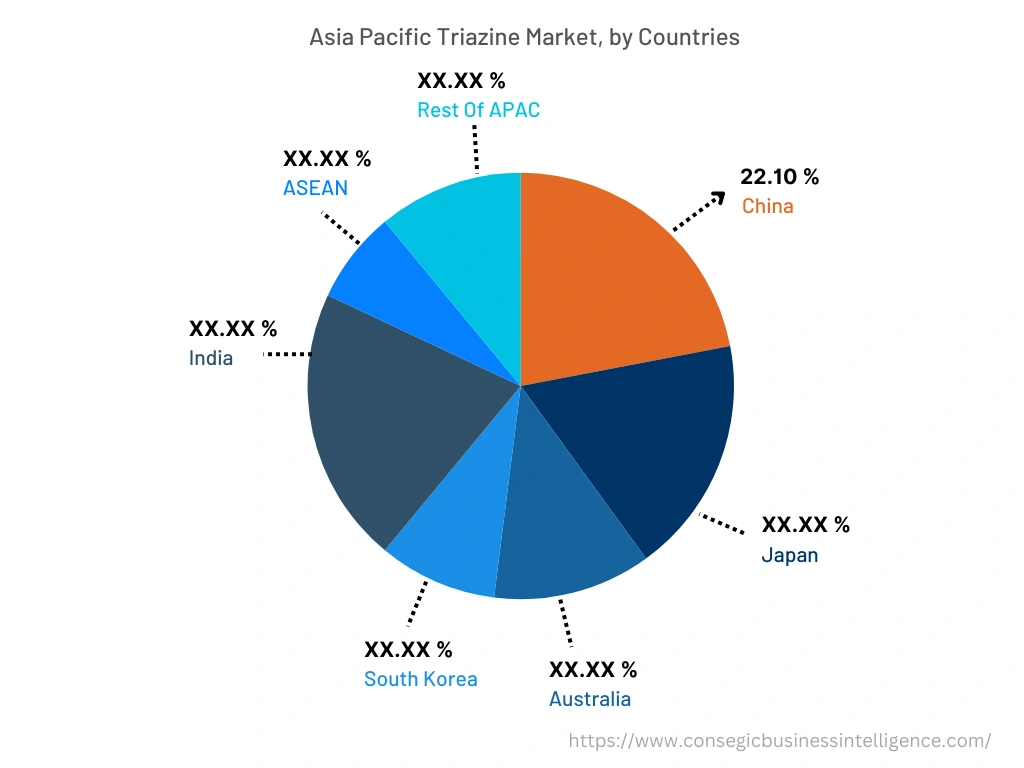
Top Key Players & Market Share Insights:
The triazine market is highly competitive, with several large players and numerous small and medium-sized enterprises. These companies have strong research and development capabilities and a strong presence in the triazine market through their extensive product portfolios and distribution networks. The market is characterized by intense competition, with companies focusing on expanding their product offerings and increasing their market share through mergers, acquisitions, and partnerships. The key players in the triazine industry include-
Recent Industry Developments :
- In January 2020, Foremark Performance Chemicals finished expanding its triazine production activities at its La Porte factory in Texas. Owing to rising shale oil and gas production in North America and Foremark's compelling value offer, the capacity expansion indicates a significant rise.
- In February 2023, Eastman Chemical Company acquired Ai-Red Technology (Dalian) Co., Ltd., a manufacturer and supplier of paint protection and window film for auto and architectural markets in the Asia Pacific region. This acquisition demonstrates Eastman's commitment to driving growth in performance films and the paint protection and window film markets.
Key Questions Answered in the Report
What was the market size of the triazine industry in 2024? +
In 2024, the market size of triazine was USD 426.76 million.
What will be the potential market valuation for the triazine industry by 2032? +
In 2032, the market size of triazine will be expected to reach USD 591.25 million.
What are the key factors driving the growth of the triazine market? +
Growing demand in the construction and automotive industries is fueling market growth at the global level.
What is the dominating segment in the triazine market by type? +
In 2024, the up to 1,3,5-triazine segment accounted for the highest market share of 41.55% in the overall triazine market.
Based on current market trends and future predictions, which geographical region is the dominating region in the triazine market? +
Asia Pacific accounted for the highest market share in the overall triazine market.
